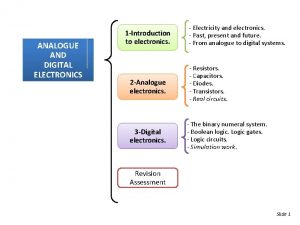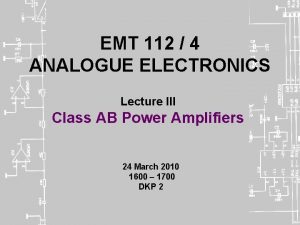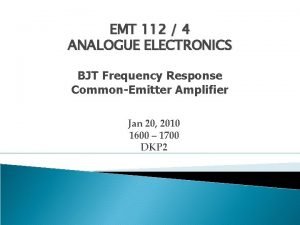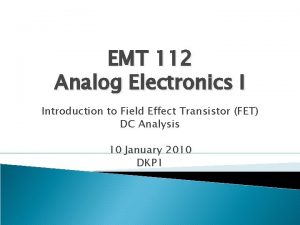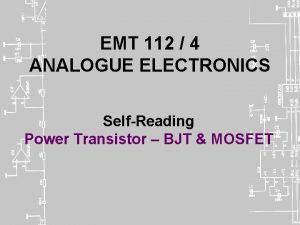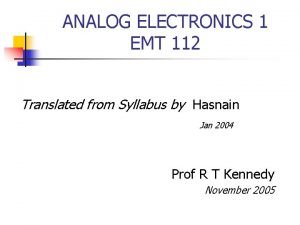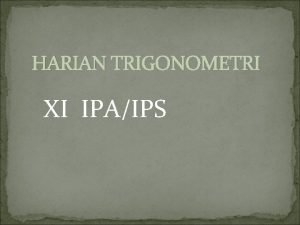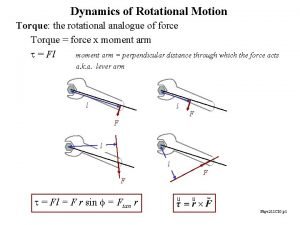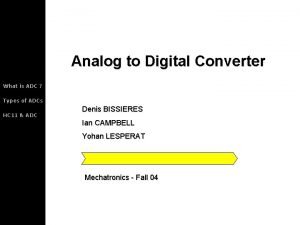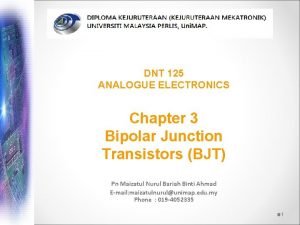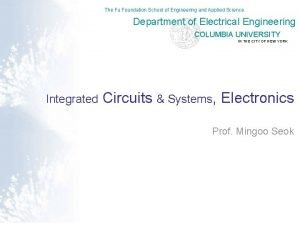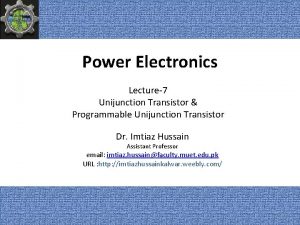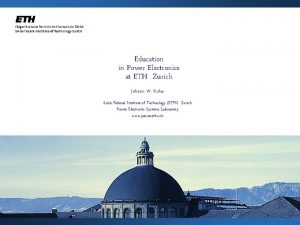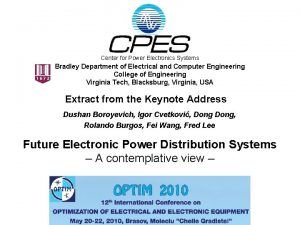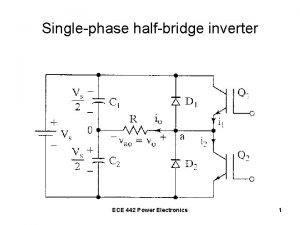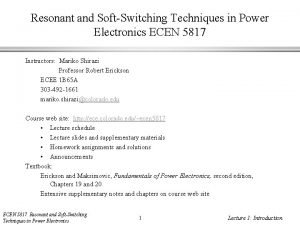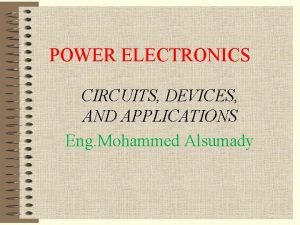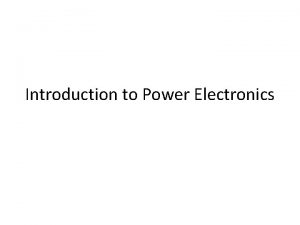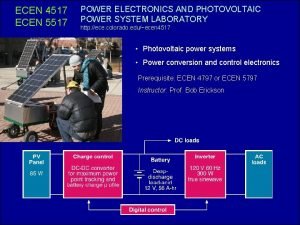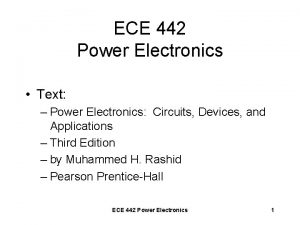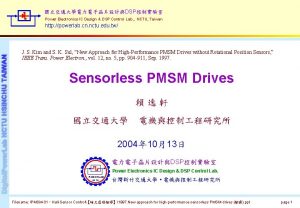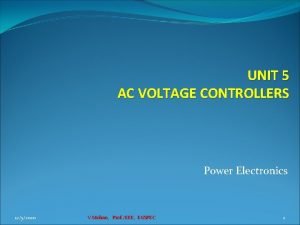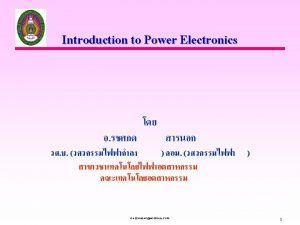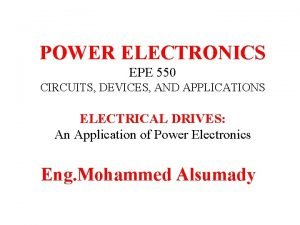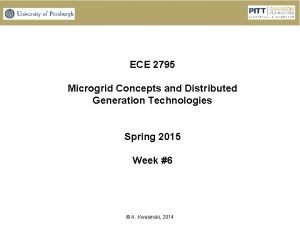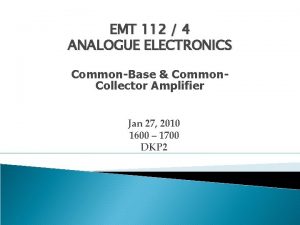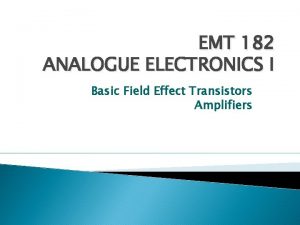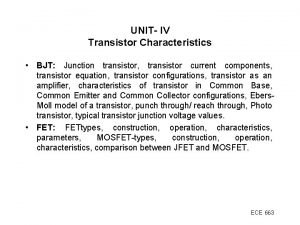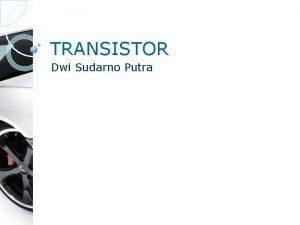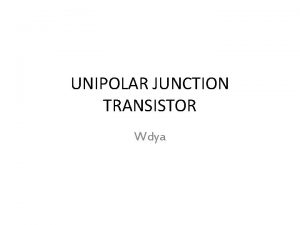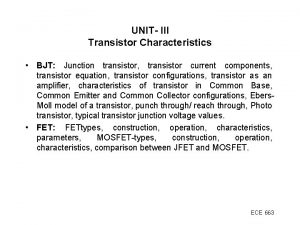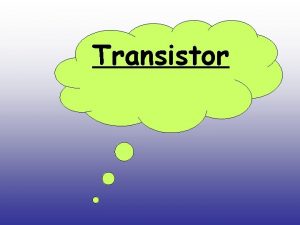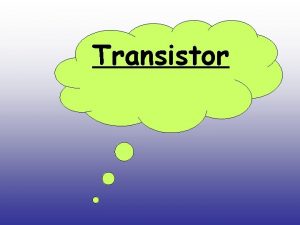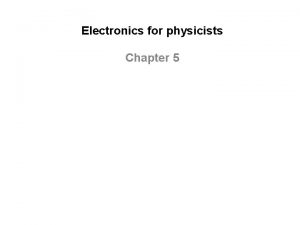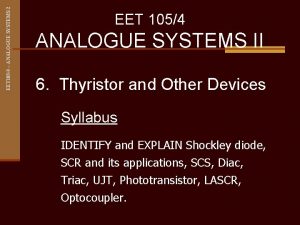EMT 112 4 ANALOGUE ELECTRONICS SelfReading Power Transistor







































- Slides: 39

EMT 112 / 4 ANALOGUE ELECTRONICS Self-Reading Power Transistor – BJT & MOSFET

POWER TRANSISTOR Transistor limitations • Maximum rated current, • Maximum rated voltage, • Maximum rated power. The maximum rated power is related to the maximum allowable temperature of the transistor.

POWER TRANSISTOR – BJT Large-area devices – the geometry and doping concentration are different from those of small-signal transistors Examples of BJT rating: Parameter VCE (max) (V) IC (max) (A) PD (max) (W) f. T (MHz) Small-signal BJT (2 N 2222 A) Power BJT (2 N 3055) (2 N 6078) 40 0. 8 1. 2 35 – 100 300 60 15 115 5 – 20 0. 8 250 7 45 12 – 70 1

POWER TRANSISTOR – BJT Current gain depends on IC and is smaller in power BJT. The maximum rated collector current, IC(rated) may be related to the following: 1. maximum current that connecting wires can handle 2. The collector current at which the gain falls below a minimum specified value 3. current which leads to maximum power dissipation when the transistor is in saturation.

POWER TRANSISTOR Typical dc beta characteristics ( h. FE versus IC) for 2 N 3055 – BJT

POWER TRANSISTOR – BJT Current gain depends on IC and is smaller in power BJT. The maximum rated collector current, IC(rated) may be related to the following: 1. maximum current that connecting wires can handle 2. The collector current at which the gain falls below a minimum specified value 3. current which leads to maximum power dissipation when the transistor is in saturation.

POWER TRANSISTOR – BJT Current gain depends on IC and is smaller in power BJT. The maximum rated collector current, IC(rated) may be related to the following: 1. maximum current that connecting wires can handle 2. The collector current at which the gain falls below a minimum specified value 3. current which leads to maximum power dissipation when the transistor is in saturation.

POWER TRANSISTOR – BJT The maximum voltage limitation: • Avalanche breakdown in the reverse-biased basecollector junction (VCEO); • Second breakdown – nonuniformities in current density which inreases temperature in local regions in semiconductor.

POWER TRANSISTOR – BJT IC–VCE characteristics showing breakdown effect

POWER TRANSISTOR – BJT The instantaneous power dissipation in transistor The second term is usually small, hence; The average power over one cycle

POWER TRANSISTOR – BJT The average power dissipated in a BJT must be kept below a specified maximum value to ensure that the temperature of the device does not exceed the maximum allowable value. If collector current and collector-emitter voltage are dc quantities, the maximum rated power, PT The power handling ability of a BJT is limited by two factors, i. e. junction temperature and second breakdown. SOA must be observed, i. e. do not exceed BJT power dissipation.

POWER TRANSISTOR – BJT The safe operating area (SOA) is bounded by IC(max); VCE(sus) and PT (Figure) SOA of a BJT (linear scale)

POWER TRANSISTOR – BJT SOA of a BJT (log scale)

POWER TRANSISTOR EXAMPLE I Determine the required ratings (current, voltage and power) of the BJT. – BJT

POWER TRANSISTOR EXAMPLE I – Solution For the maximum collector current; For the maximum collectoremitter voltage; – BJT

POWER TRANSISTOR EXAMPLE I – Solution The load line equation is; The load line must lie within the SOA The transistor power dissipation; – BJT

POWER TRANSISTOR EXAMPLE I – Solution The maximum power occurs when i. e. when or when At this point; and; – BJT

POWER TRANSISTOR – BJT EXAMPLE I – Solution Thus the transistor ratings are; In practice, a safety factor is normally used. The transistor with chosen. will be

POWER TRANSISTOR Physical structure; • Large emitter area to handle large current • Narrow emitter width to minimize parasitic base resistance • May include small resistors (ballast resistor) in emitter leg to help maintain equal currents in each B–E junction. – BJT

POWER TRANSISTOR – MOSFET Example of power MOSFET parameters; Parameter VDS(max) (V) ID(max) (A) - @ T = 25 C PD (W) 2 N 675 7 150 2 N 679 2 400 8 2 75 20

POWER TRANSISTOR – MOSFET The superior characteristics of MOSFETs are; • Faster switching time; • No second breakdown; • Stable gain and response time over a wide temperature range (Figure in the next slide).

POWER TRANSISTOR Transconductance versus drain current curves for various values of temperature – less than the variation in BJT current gain. – MOSFET

POWER TRANSISTOR Transfer characteristics curves for various values of temperature. – MOSFET

POWER TRANSISTOR Structure – MOSFET

POWER TRANSISTOR Structure DMOS process can be used to produce a large number of hexagonal cells on a single chip. – MOSFET

POWER TRANSISTOR Structure These hexagonal cells can be paralleled to form large-area devices without the need of emitter ballast resistance. A single power MOSFET may contain as many as 25, 000 parallel cells. – MOSFET

POWER TRANSISTOR The “ON” resistive path between drain and source (rds(on)) is an important parameter in power capability of MOSFET – MOSFET

POWER TRANSISTOR BJT – Comparison MOSFET Requires complex input circuitry because of high input current (currentcontrolled device) Simple input circuitry because of low input current (voltage-controlled device). More sensitive to temperature variation – thermal runaway and problem of second breakdown. More immune to thermal runaway and second breakdown.

POWER TRANSISTOR – Heat sinks • The power dissipated in a transistor can cause an internal temperature rise above ambient temperature. • This heat, if not properly removed, may cause internal temperature above a safe limit and can cause permanent damage to transistor. • Heat may be removed through proper packaging:

POWER TRANSISTOR – Heat sinks • Additionally, heat sinks can be used to remove the heat developed in the transistor:

POWER TRANSISTOR – Heat sinks Temperature of transistor junction Ambient temperature Temperature difference Voltage difference Electrical equivalent circuit of thermalconduction process Thermal resistance between the junction and ambient Electrical resistance Thermal power through the element Electric current.

POWER TRANSISTOR Manufacturers’ data sheet for power devices generally give: • maximum operating junction (device) temperature, TJmax; • thermal resistance from the junction to the case, JC; The temperature conduction process may be represented as follows: – Heat sinks

POWER TRANSISTOR The following equation can be used to describe the temperature conduction process: If the heat sink is not used, then; – Heat sinks

POWER TRANSISTOR – Heat sinks EXAMPLE II A MOSFET has the following parameters; Determine the maximum power dissipation in the transistor and determine the temperature of the transistor case and heat sink.

POWER TRANSISTOR EXAMPLE II – Solution Maximum power (without heat sink) Maximum power (with heat sink) – Heat sinks

POWER TRANSISTOR EXAMPLE II – Solution (cont’d) Heat sink temperature – Heat sinks

POWER TRANSISTOR EXAMPLE II – Solution (cont’d) Case temperature Note: The use of heat sink allows more power to be dissipated in the device. – Heat sinks

POWER TRANSISTOR – Heat sinks Power derating curve Manufacturer usually specifies: • the maximum temperature TJmax; • the maximum power dissipation PDmax, at a particular ambient temperature TA 0 (usually 25 C); and • thermal resistance JA. In addition, a graph – power derating curve is provided.

POWER TRANSISTOR – Heat sinks Power derating curve For operation below TA 0, the device can safely dissipate the rated value of PD 0 watts. If the device is to be operated at higher ambient temperature, the maximum allowable power dissipation must be derated according to the straight line.
 Analogue and digital electronics
Analogue and digital electronics Emt 112
Emt 112 Calculating frequency response
Calculating frequency response Emt 112
Emt 112 Transistor power dissipation
Transistor power dissipation Emt 112
Emt 112 Cos 112,5
Cos 112,5 Wheeled ambulance stretcher
Wheeled ambulance stretcher Torque
Torque Analog and digital signals in computer networking
Analog and digital signals in computer networking Types of analog to digital converter
Types of analog to digital converter How to write time in analogue
How to write time in analogue Digital vs analog transmission
Digital vs analog transmission Analogue door phone
Analogue door phone Analogue studies are used when researchers ____.
Analogue studies are used when researchers ____. Visual analogue mood scale
Visual analogue mood scale Analogue chapter 3
Analogue chapter 3 Stelarc ear
Stelarc ear Status digital analogue
Status digital analogue Power triangle formula
Power triangle formula Fu foundation school of engineering
Fu foundation school of engineering Colorado boulder power electronics
Colorado boulder power electronics Intrinsic standoff ratio of ujt
Intrinsic standoff ratio of ujt Johann w. kolar
Johann w. kolar Center for power electronics systems
Center for power electronics systems Ampegon power electronics ag
Ampegon power electronics ag Ece 442
Ece 442 Switch network
Switch network Power electronics circuits devices and applications
Power electronics circuits devices and applications Introduction to power electronics
Introduction to power electronics Power transfer system
Power transfer system Power electronics
Power electronics Dsp in power electronics
Dsp in power electronics Ac voltage controller and cycloconverter
Ac voltage controller and cycloconverter Power electronics
Power electronics Power electronics
Power electronics Rectifier power electronics
Rectifier power electronics Emt competence framework
Emt competence framework Emt setup
Emt setup Chapter 8 lifting and moving patients
Chapter 8 lifting and moving patients
